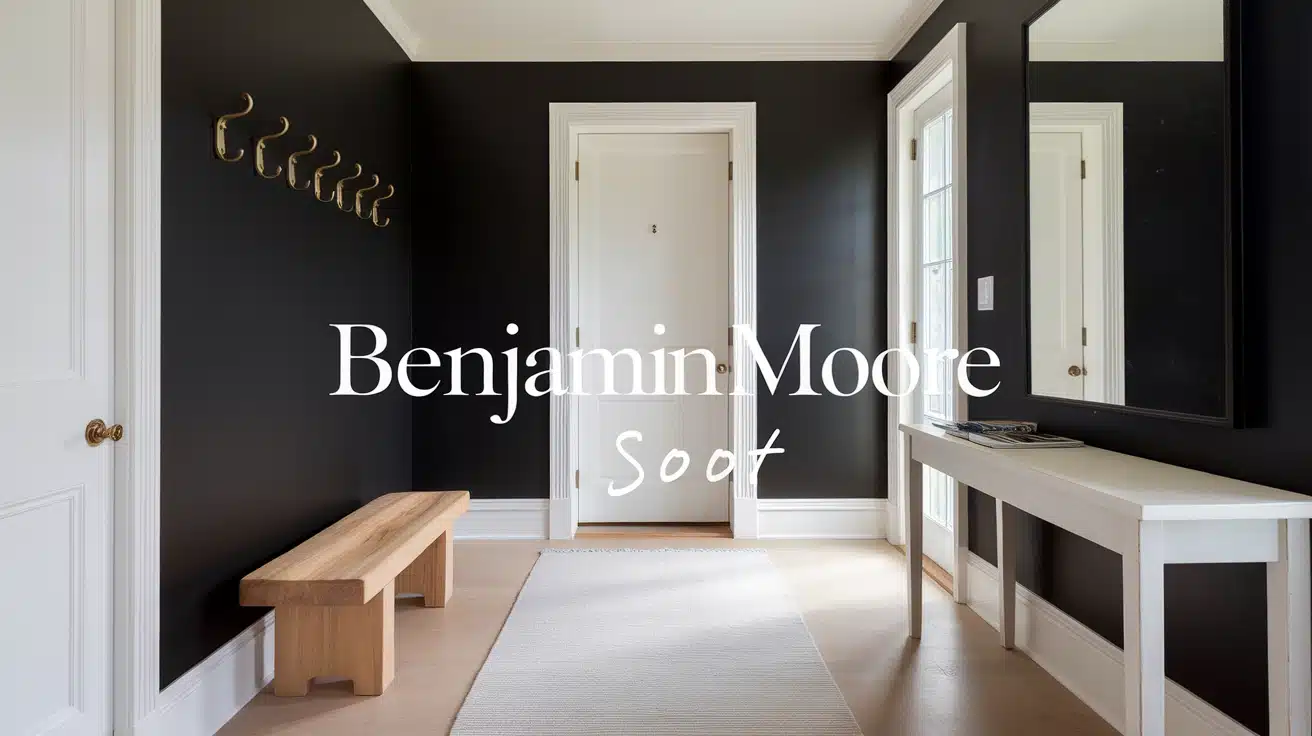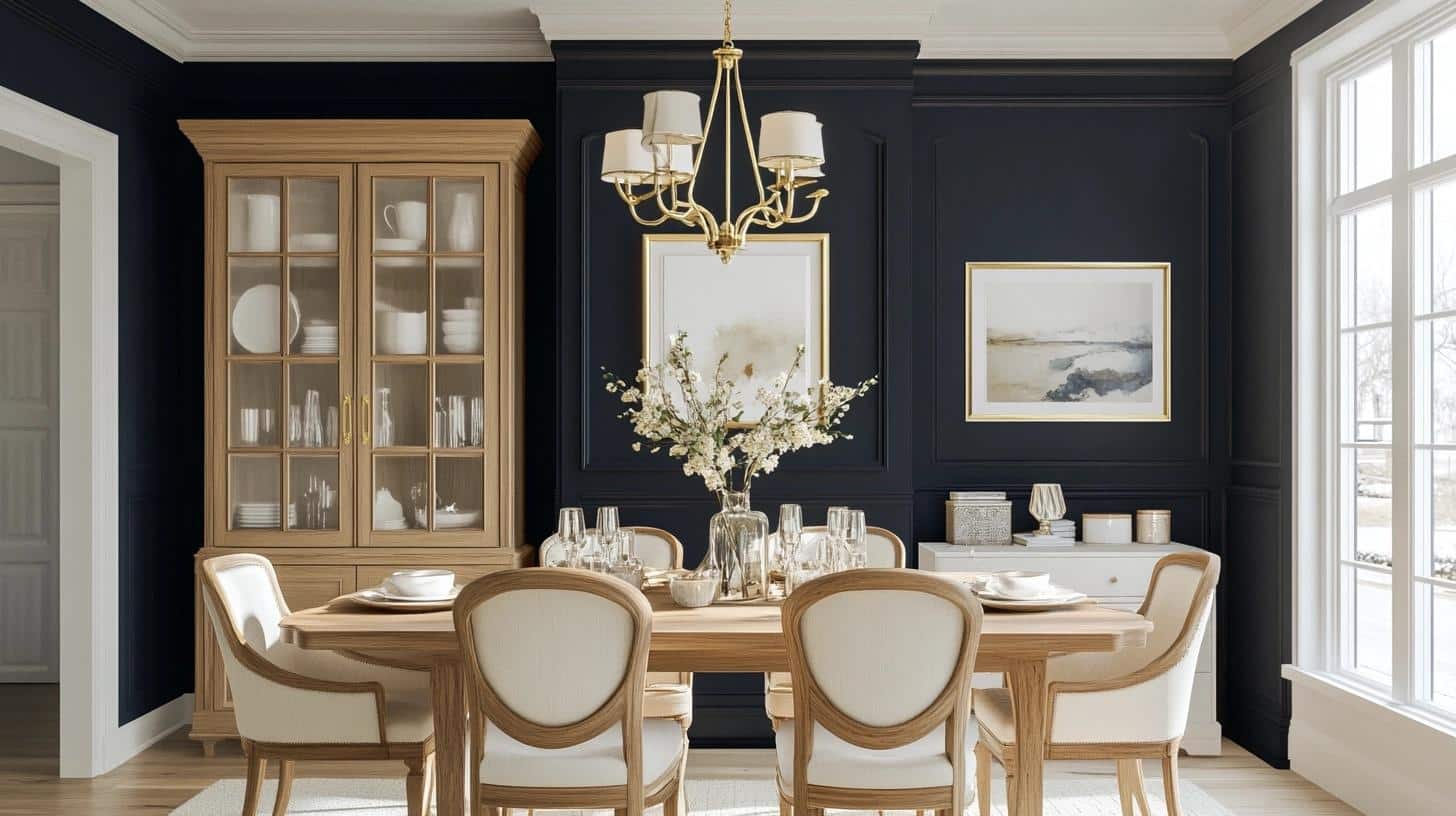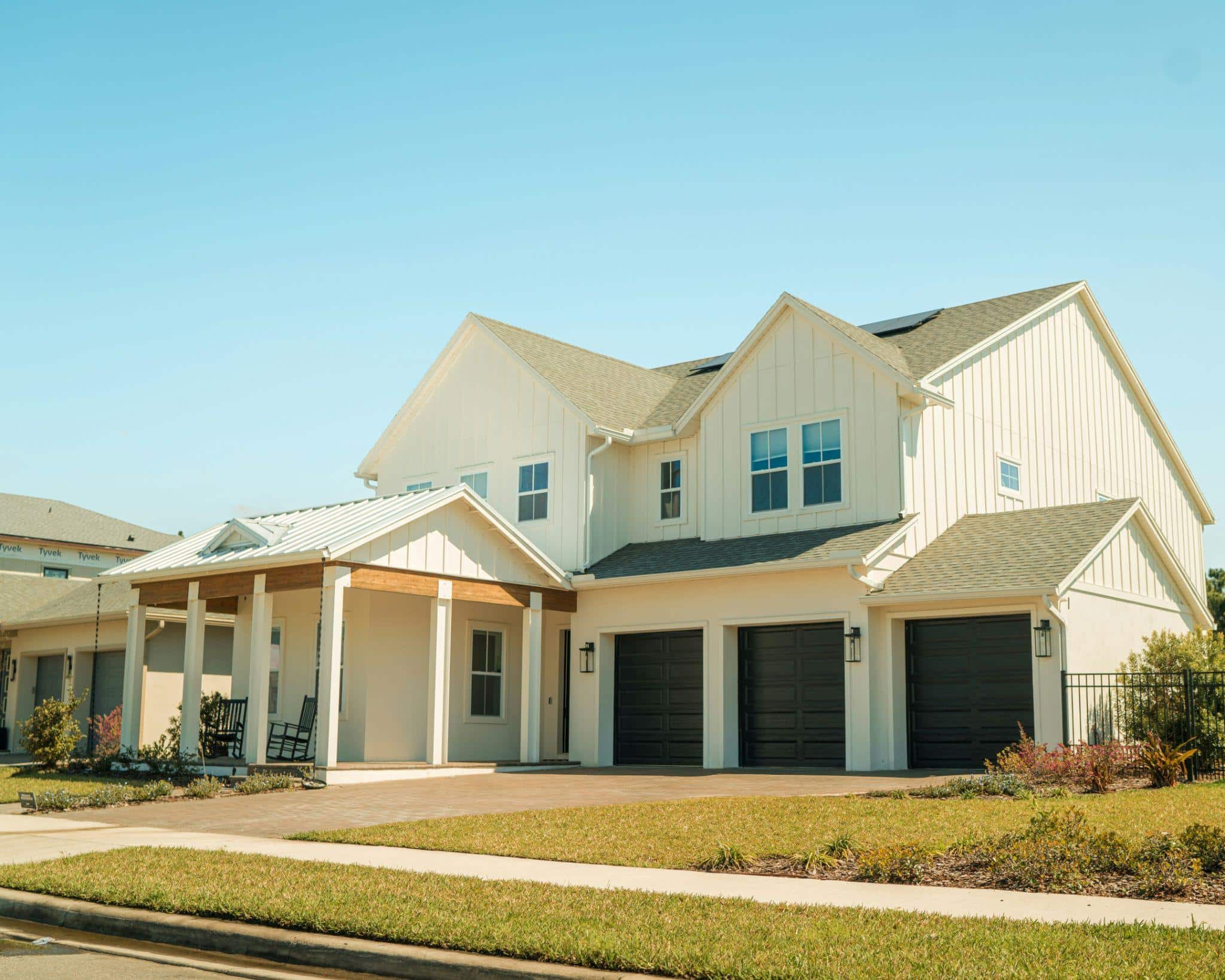Finding the perfect black paint can feel like searching for a needle in a haystack. I know how frustrating it is to test sample after sample, only to end up with blacks that look too harsh or flat on your walls.
I’m excited to introduce Benjamin Moore Soot (2129-20), a black paint with subtle blue undertones.
In this post, I’ll explain everything about Soot, from its unique color profile and best lighting conditions to ideal room placements and styling tips to help you confidently use this shade.
Let’s jump right in!
Understanding Benjamin Moore Soot
Let me tell you why Benjamin Moore Soot (2129-20) caught my attention. This shade sits between pure black and deep navy, offering a softer look than standard black paint.
With an LRV (Light Reflectance Value) of 6.19, it absorbs most light while still showing its character.
Looking at Soot in different lights, I notice its rich depth. The RGB values reveal its structure: it contains subtle red, green, and blue pigments. These work together to create a black that feels natural, not artificial.
The blue undertones in Soot make it special. I’ve seen how these undertones become more visible in bright spaces, while in dim lighting, the color reads as a true black.
The gray notes help balance the color, preventing it from feeling too heavy. The hex code of Benjamin Moore Soot is #363C40.
Warm vs. Cool Blacks:
I often explain to my clients that not all blacks are the same. Warm blacks have red, brown, or yellow undertones, creating a cozy feeling.
Cool blacks, like Soot, contain blue or green undertones, offering a crisp, fresh look.
Soot sits firmly in the cool black family. I love how its blue undertones create a sophisticated feel without becoming too cold. This makes it more flexible than pure black when working with different color schemes.
Click here to buy Benjamin Moore Soot.
Best Lighting Conditions for Benjamin Moore Soot
I’ve painted many rooms with Soot and learned exactly how light affects this color. Let me share what I’ve found about getting the most from this shade in your home.
Natural Light:
- South-facing rooms bring out Soot’s true character. The constant sunlight shows off its blue hints beautifully.
- In north-facing spaces, I see Soot take on a deeper appearance. Here, it looks more like a pure black.
- East and west-facing rooms create interesting effects; morning sun in east-facing rooms highlights the blue tones, and evening light in west-facing spaces warms up the color slightly
Indoor Lighting Tips:
I recommend layered lighting for the best results:
- Use white LED bulbs (3000-4000K) for main lighting
- Add task lights in corners to prevent dark spots
- Install wall sconces to create soft washes of light
Here’s what I’ve noticed about timing: Soot looks most striking during mid-day when natural light is strongest. The color stays true without appearing too dark or losing its subtle blue quality.
A quick tip from my experience: Test Soot in different spots before painting an entire room. Watch how it changes from morning to evening. This helps you understand exactly how the color will behave in your space.
Stunning Rooms Featuring Benjamin Moore Soot
Benjamin Moore Soot is a classy near-black paint with subtle blue undertones that add depth and beauty to any space. Its rich, cool hue creates a dramatic yet refined backdrop, making lighter furnishings and décor truly stand out.
The following are a few rooms featuring Benjamin More soot.
1. Bedroom
I love using Soot in bedrooms to create a peaceful sleeping space. Here’s what I’ve learned about making it work perfectly:
- Paint only one wall as an accent behind the bed
- Mix in white bedding for clear contrast
- Add brass or silver lamps to catch the light
- Keep wood furniture natural for warmth
- Use white trim to frame the walls
In smaller bedrooms, I stick to a single Soot wall. For larger rooms, this shade works on all walls without feeling heavy. Light-colored decor keeps the balance just right.
Remember to consider your ceiling height. In rooms with standard 8-foot ceilings, I like to keep the ceiling light to maintain an open feeling. You might try painting the ceiling in Soot with higher ceilings for an immersive effect.
2. Kitchen
Soot makes kitchen cabinets look stunning. It grounds the space perfectly for lower cabinets. White countertops and backsplash tiles create a beautiful contrast.
If you’re hesitant about dark cabinets, try painting your kitchen island in Soot. It will become a striking focal point without being overwhelming.
3. Living room
In living rooms, I find Soot creates the perfect backdrop for family gatherings and quiet evenings. Let me share my top tips for using this shade:
- Keep your sofa light – white, cream, or gray work best
- Layer textured throw pillows to soften the dark walls
- Add white built-ins or shelving for display areas
- Mix in natural wood coffee tables and side pieces
I often paint Soot on the TV wall – it helps the screen blend in when not in use. My favorite trick is adding large white art pieces or family photos.
They stand out beautifully against this rich background. Glass tables reflect light and keep the room feeling open.
4. Bathroom
In bathrooms, I’ve discovered Soot creates a spa-like feeling. White fixtures stand out beautifully against this dark shade.
Perfect pairings I always use:
- White subway tiles
- Marble countertops
- Chrome or brass fixtures
- Clear glass shower doors
For small bathrooms, I suggest painting just the vanity wall. I love adding round mirrors with brass frames – they pop against the deep background and reflect plenty of light.
5. Dining Room
I’ve seen Soot create pure magic in dining rooms. This shade sets the mood for both casual family meals and special gatherings.
Wall options that work best:
- All four walls for an intimate feel
- Accent wall behind a buffet table
- Two-facing walls for balance
My favorite furniture pairings:
- Light-colored dining chairs for contrast
- Natural wood table for warmth
- Glass cabinet fronts to reflect light
- White china cabinet for display
A ceiling light fixture in gold or brass adds sparkle against Soot walls. I like using white table linens and light window treatments to balance the dark walls.
For art, I suggest large white-framed pieces or mirrors to bounce light around the room.
The key to success? Mix in plenty of light elements to keep the space open and bright.
6. Entryway
I’ve found Soot makes a bold first impression in entryways. Here’s how I make it shine in this space:
Light-colored elements that pop:
- White door trim and baseboards
- Pale tile or wood flooring
- Bright ceiling light fixtures
Must-have pieces:
- Large mirror to reflect light
- Small bench in natural wood
- Light-colored runner or rug
- Wall hooks in brass finish
For narrow entryways, I paint just one wall in Soot. In larger foyers, all walls work well. My favorite setup includes a white console table against the dark walls – it creates a perfect spot for keys and mail.
Exterior Uses for Benjamin Moore Soot
Benjamin Moore Soot is a bold, saturated black with subtle blue undertones that brings a modern, classy edge to home exteriors. With specialized exterior formulas soot stands up to harsh weather, moisture, and fading, making it a durable and striking choice for outdoor applications
Regarding outdoor applications, I’ve seen Soot make simple updates look high-end. Let me share my go-to ways to use this color outside.
Front Doors:
Soot looks sharp on doors against:
- White siding
- Red brick
- Graystone
- Tan stucco
A Soot front door makes a statement without shouting. I pair it with brass hardware and simple light fixtures for a clean look. Clear glass panels in the door let light through while framing the view beautifully.
Window Trims:
Works well on:
- White houses for contrast
- Gray homes for depth
- Wood siding for a modern touch
The key to window trims? Keep it consistent. I paint all trims in Soot to create a unified look. Black screens blend better with Soot trim, making windows appear seamless from the street.
How To Maintain Walls Painted with Benjamin Moore Soot?
Walls painted with Benjamin Moore Soot benefit from the brand’s high-quality, durable paint technology that resists fading and wear. The following are a few tips to maintain walls painted with Benjamin Moore soot.
- Use a soft microfiber cloth for weekly dust removal to keep the finish looking fresh.
- Clean marks or spots right away with a gentle soap and water mix.
- Pat walls dry with a clean cloth after cleaning – no rubbing or scrubbing.
- Keep window treatments closed during peak sun hours to stop fading.
- Touch up any scratches quickly with a small artist brush to keep walls perfect.
- Check walls every month for water stains, especially in bathrooms and kitchens.
- Use a feather duster for cobwebs to avoid leaving marks on the dark surface.
- Keep temperature steady in rooms to stop paint from expanding and cracking.
- Fix any wall damage before it affects the paint finish.
- Write down your paint code (2129-20) for easy touch-ups later.
- Store leftover paint in a cool, dry spot for future fixes.
- Clean air vents often to stop dust from settling on walls.
Summing It Up
Let’s wrap up our look at Benjamin Moore Soot.
This rich black with blue notes can turn any room into something special. I’ve shown you how it works in different spaces, from cozy bedrooms to striking entryways.
Remember, the key is balance – mix Soot with light colors and natural materials. Good lighting helps show off its true character. With proper care, these walls will stay beautiful for years.
Want to explore more unique paint colors? Check out my other guides about Sherwin Williams Ripe Olive, a muted green that brings nature inside. Or see Benjamin Moore’s Vintage Vogue and Carolina Gull – both offer special charm for different spaces.
Feel free to share your Soot painting projects in the comments. I’d love to see how you use this classic shade!















